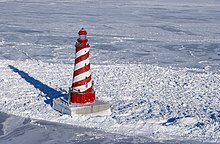White Shoal Light (Michigan)
 |
|
| Location | Lake Michigan west of the Straits of Mackinac, Emmet County, Michigan |
|---|---|
| Coordinates | 45°50′32″N 85°8′7″W / 45.84222°N 85.13528°WCoordinates: 45°50′32″N 85°8′7″W / 45.84222°N 85.13528°W |
| Year first lit | 1910 |
| Automated | 1976 |
| Foundation | cofferdam/timber exposed Crib pier/concrete pier. |
| Construction | Terra Cotta//steel/brick interior;gunnite exterior; aluminium lantern |
| Tower shape | Octagonal base on building; frustum of a cone. |
| Markings / pattern | White orig./Red and White barber pole tower, red lantern & base |
| Height | Tower - 124 feet (38 m) |
| Focal height | Focal plane - 125 feet (38 m) |
| Original lens | 2nd order bivalve Fresnel Lens |
| Current lens | 7.5-inch (190 mm) Tideland Signal acrylic lens |
| Intensity | 1.2 million candle power |
| Range | 17 nautical miles (31 km; 20 mi) |
| Characteristic | flashing 5 sec |
| Fog signal | Diaphone originally, HORN 1 blast every 30", 3" blast. Operates year round. |
| Racon | "K" (– • –). |
| ARLHS number | USA-886 |
| USCG number |
7-17750 |
|
White Shoal Light Station
|
|
| Nearest city | Mackinaw City, Michigan |
| Area | 0.1 acres (0.040 ha) |
| Architect | Judson, Major William V. |
| MPS | U.S. Coast Guard Lighthouses and Light Stations on the Great Lakes TR |
| NRHP Reference # | 84001391 |
| Added to NRHP | July 19, 1984 |
7-17750
The White Shoal Light is a lighthouse located 20 miles (32 km) west of the Mackinac Bridge in Lake Michigan. It is an active aid to navigation.
The period between 1852 and the beginning of the 20th century saw great activity on the Great Lakes by the United States Lighthouse Board. Between 1852 and 1860 26 new lights were built. Even as the United States Civil War and its aftermath slowed construction, a dozen new lights were still lit in that decade. In the 1870s, 43 new lights were built on the Lakes. The 1880s saw more than one hundred lights constructed.
As the new century began, on the Great Lakes the Lighthouse Board operated 334 major lights, 67 fog horns and 563 buoys.
During the 19th century design of Great Lakes lights slowly evolved. Until 1870 the most common design was to build a keeper's dwelling with the light on the dwelling's roof or on a relatively small square tower attached to the house. In the 1870s, so as to raise lights to a higher focal plane, conical brick towers, usually between eighty and one hundred feet tall were constructed. In the 1890s steel lined towers began to replace the older generation of brick building.See Big Sable Point Light for a striking transition and transformation.
The White Shoal Light was the culmination of a forty-year effort—between 1870 and 1910—where engineers began to build lights on isolated islands, reefs, and shoals that were significant navigational hazards. To that time, Light ships were the only practical way to mark the hazards, but were dangerous for the sailors who manned them, and difficult to maintain. "Worse, regardless of the type of anchors used lightships could be blown off their expected location in severe storms, making them a potential liability in the worst weather when captains would depend on the charted location of these lights to measure their own ship's distance from dangerous rocks."See, United States lightship Huron (LV-103).
...
Wikipedia

